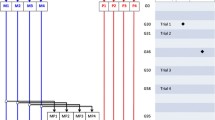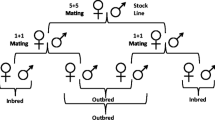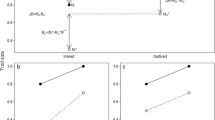Abstract
Previous studies have shown that the esterase 6 (EST6) enzyme ofD. melanogaster is mainly produced in the sperm ejaculatory duct of the adult male and comparisons of wild-type males with laboratory null mutants have suggested that the enzyme plays a role in reproductive fitness. In this study we have compared 18 field-derived lines each isoallelic forEst6 for differences in five components of male reproductive fitness. No consistent fitness differences were found among lines differing in respect of the two major allozyme classes EST6-F and EST6-S, despite other evidence that these two classes are not selectively equivalent in the field. However, differences in reproductive fitness were found among lines differing in the minor mobility variants that segregate within EST6-F and EST6-S. A failure to distinguish among these minor forms may explain the discrepancies in previous studies on the effects of the major EST6 allozymes on reproductive fitness. The most significant associations we have found between EST6 and reproductive fitness were due to variation in EST6 activity levels. Male EST6 activity levels were found to be positively correlated with their time to first mating, negatively correlated with the numbers of eggs laid and progeny produced by their mates, and negatively correlated with the frequency with which their mates remate. We conclude that some EST6 variants differ in components of male reproductive fitness operative in laboratory cultures. However, the evidence for fitness differences is stronger for variants affecting the amount, rather than the structure of the enzyme, and the direction of the differences varies between some of the fitness components tested.
Similar content being viewed by others
References
Abedin, K., S. McNamara, D. Osterbur & W.W.M. Steiner, 1980. Studies on the effect of temperature on fitness and fecundity at the esterase 6 locus inD. melanogaster. Dros. Inform. Serv. 55:10–11.
Aigaki, T., I. Fleischmann, P.S. Chen & E. Kubli, 1991. Ectopic expression of sex peptide alters reproductive behaviour of femaleD. melanogaster. Neuron 7:557–563.
Anderson, P.R. & J.G. Oakeshott, 1984. Parallel geographic patterns of allozyme variation in two siblingDrosophila species. Nature 308:729–731.
Bauman, H., 1974. Biological effects of paragonial substances PS-1 and PS-2 in females ofDrosophila funebris. J. Insect Physiol. 20:2347–2362.
Birley, A.J. & J.A. Beardmore, 1977. Genetical composition, temperature, density and selection in an enzyme polymorphism. Heredity 39:133–144.
Boulétreau-Merle, J., 1977. Roles des spermatheques dans l'utilisation du sperme et la stimulation d'ovogenese chezDrosophila melanogaster. J. Insect Physiol. 23:1099–1104
Cooke, P.H., R.C. Richmond & J.G. Oakeshott, 1987. High resolution electrophoretic variation at the esterase 6 locus in a natural population ofDrosophila melanogaster. Herdity 59:259–264.
Cooke, P.H. & J.G. Oakeshott, 1989. Amino acid polymorphisms for esterase 6 inDrosophila melanogaster. Proc. Natl. Acad. Sci. USA 86:1426–1430.
Dolan, R. & A. Robertson, 1975. The effect of conditioning the medium inDrosophila, in relation to frequency-dependent selection. Heredity 35:311–316.
Fuerst, P.A., W.W. Pendelbury & J.F. Kidwell, 1973. Propensity for multiple mating inDrosophila melanogaster females. Evolution 27:265–268.
Game, A.Y. & J.G. Oakeshott, 1989. Variation in the amount and activity of esterase 6 in a natural population ofDrosophila melanogaster. Heredity 62:27–34.
Game, A.Y. & J.G. Oakeshott, 1990. Association between restriction site polymorphism and enzyme activity variation for esterase 6 inDrosophila melanogaster. Genetics 126:1021–1031.
Gilbert, D.G., 1981. Ejaculate esterase 6 and initial sperm use by femaleDrosophila melanogaster. J. Insect Physiol. 9:641–650.
Gilbert, D.G., 1985. Estimating single gene effects on quantitative traits. Theor. Appl. Genet. 69:625–629.
Gilbert, D.G. & R.C. Richmond, 1982. Esterase 6 inDrosophila melanogaster: reproductive function of active and null alleles at low temperature. Proc. Natl. Acad. Sci. USA 79:2962–2966.
Gilbert, D.G., R.C. Richmond & K.B. Sheehan, 1981. Studies of esterase 6 inDrosophila melanogaster. V. Progeny production and sperm use in females inseminated by males having active or null alleles. Evolution 31:21–37.
Gromko, M.H., D.G. Gilbert & R.C. Richmond, 1984. Sperm transfer and use in the multiple mating system ofDrosophila. In: Smith, R.L. (ed.). Sperm Competition and the Evolution of Animal Mating Systems. Academic Press, New York, pp 371–426.
Happ, G.M., 1992. Maturation of the male reproductive system and its endocrine regulation. Ann. Rev. Entomol. 37:303–320.
Hatakoshi, M., 1992. An inhibitory mechanism over oviposition in the tobacco cutworm,Spodoptera litura by juvenile hormone analogue Pyriproxyfen. J. Insect. Physiol. 38:793–801.
Healy, M.J., M.M. Dumancic & J.G. Oakeshott, 1991. Biochemical and physiological studies of soluble esterases fromDrosophila melanogaster. Biochem. Genet. 29:365–388.
Kalb, J.M., A.J. Dibenedetto & M.F. Wolfner, 1993. Probing the function ofDrosophila melanogaster accessory glands by directed cell ablation. Proc. Natl. Acad. Sci. USA 90:8093–8097.
Kojima, K. & S.L. Huang, 1972. Effects of population density on the frequency dependent selection in the esterase 6 locus ofDrosophila melanogaster. Evolution 26:313–321.
Korochkin, L.I., E.S. Belyaeva, N.M. Matveeva, B.A. Kuzin & O.L. Serov, 1976. Genetics of esterases inDrosophila. IV. Slow migrating S-esterase inDrosophila of thevirilis group. Biochem. Genet. 14:161–182.
Kubli, E., 1992. The sex peptide. Bioessays 14:779–784.
Labate, J., A. Bortoli, A.Y. Game, P.H. Cooke & J.G. Oakeshott, 1989. The number and distribution of esterase 6 alleles in populations ofDrosophila melanogaster. Heredity 63:203–208.
Lewontin, R.C., 1985. Population genetics. Ann. Rev. Genet. 19:81–102.
Ludwig, M.Z., N.A. Tamarina & R.C. Richmond, 1993. Localisation of sequences controlling the spatial, temporal and sex-specific expression of the esterase 6 locus inDrosophila melanogaster adults. Proc. Natl. Acad. Sci. USA 90:6233–6237.
Miekle, D.B. & R.C. Richmond, 1990. Localisation and long-evity of seminal-fluid esterase 6 in mated femaleDrosophila melanogaster. J. Insect Physiol. 36:93–101.
Miekle, D.B. & R.C. Richmond, 1991. Temperature and sex-specific differences in reproduction related to genotypic variation at the esterase 6 locus inDrosophila melanogaster. Amer. Nat. 138:762–767.
Morgan, P., 1976. Frequency-dependent selection at two enzyme loci inDrosophila melanogaster. Nature 263:765–766.
Oakeshott, J.G., 1979. Selection affecting enzyme polymorphisms in laboratory populations ofDrosophila melanogaster. Oecologia 43:341–354.
Oakeshott, J.G., P.H. Cooke, R.C. Richmond, A. Bortoli, A.Y. Game & J. Labate, 1989. Molecular population genetics of structural variants of esterase 6 inDrosophila melanogaster. Genome 31:788–796.
Oakeshott, J.G., M. Saad, A.Y. Game & M.J. Healy, 1994. Causes and consequences of esterase 6 enzyme activity variation in preadultDrosophila melanogaster. Heredity 73:160–169.
Payne, C.D., 1985. (ed.) The Generalised Linear Interactive Modelling System, Release 3.77. Royal Statistical Society, London.
Richmond, R.C., K.M. Nielsen, J.P. Brady & E.M. Snella, 1990. Physiology, biochemistry and molecular biology of the Est6 locus inDrosophila melanogaster. In: Barker, J.S.F., W.T. Starmer and R.J. MacIntyre (eds.). Ecological and Evolutionary Genetics of Drosophila. Plenum, New York, pp 273–292.
Scott, D., 1986. Inhibition, of femaleDrosophila melanogaster remating by a seminal fluid protein (esterase 6). Evolution 40:1084–1091
Scott, D., 1987. The timing of the sperm effect on femaleDrosophila melanogaster receptivity. Anim. Behav. 35:142–149.
Sheehan, K., R.C. Richmond & B.J. Cochrane, 1979. Studies of esterase 6 inDrosophila melanogaster. III. The development pattern and tissue distribution. Insect Biochem. 9:443–450.
Author information
Authors and Affiliations
Rights and permissions
About this article
Cite this article
Saad, M., Game, A.Y., Healy, M.J. et al. Associations of esterase 6 allozyme and activity variation with reproductive fitness inDrosophila melanogaster . Genetica 94, 43–56 (1994). https://doi.org/10.1007/BF01429219
Received:
Accepted:
Issue Date:
DOI: https://doi.org/10.1007/BF01429219




